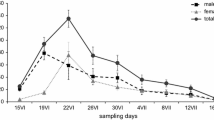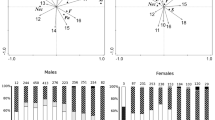Abstract
The Danube Clouded Yellow (Colias myrmidone) is one of the most endangered butterflies in Europe. Its distribution range shrank dramatically in the last few decades due to the extinction of populations in Western and Central Europe. Ecological studies were commenced when populations were already at the verge of extinction, thus our knowledge on the population ecology and habitat use of this butterfly is very limited. Here we report the results of a study on habitat preferences, egg distribution and demography of C. myrmidone in Romania, perhaps the last remaining stronghold of the species in Central Europe. We found that Danube Clouded Yellow adults occurred mainly in mesophilous grasslands created by forest clearing and then maintained by low intensity grazing allowing bushes and forest-edge vegetation to develop and host Chamaecytisus species to grow. Butterflies highly preferred lightly grazed pastures over hay meadows and abandoned grasslands, their density was positively related to host plant density. Egg-laying females preferred habitat patches with relatively high cover of the host plant and tall vegetation. Both apparent survival rate and encounter probability were lower for females than males, and parameter estimations also had much higher errors for females. These indicate that much higher sampling effort is needed to estimate and monitor population parameters for females than for males. Our results provide guidelines for the habitat management and population monitoring of Colias myrmidone, thus may significantly contribute to its successful conservation.



Similar content being viewed by others
References
Burnham KP, Anderson DR (2002) Model selection and multimodel inference, 2nd edn. Springer, New York, p 496
Cristofolini G (1991) Taxonomic revision of Cytisus Desf. Sect. Tubocytisus DC. (Fabaceae). Webbia 45(2):187–219
Dolek M, Freese A, Geyer A, Stetter H (2005) The decline of Colias myrmidone at the western edge of its range and notes on its habitat requirements. Biologia 60:607–610
Freese A, Dolek M, Geyer A, Stetter H (2005) Biology, distribution, and extinction of Colias myrmidone (Lepidoptera, Pieridae) in Bavaria and its situation in other European countries. J Res Lep 38:51–58
Gauckler K (1962) Regensburger Sandbiene, Regensburger Heufalter und Regensburger Geißklee in ihrem süddeutschen Lebensraum. Denkschr Regensburg Bot Ges NF 19:26–34
Gibson CWD, Brown VK (1992) Grazing and vegetation change: Deflected or modified succession? J Appl Ecol 29:120–131
Godwin H (1929) The subclimax and deflected succession. J Ecol 17:144–147
Hothorn T, Hornik K, Zeileis A (2006) Unbiased recursive partitioning: a conditional inference framework. J Comput Graph Stat 15:651–674
Ide J-Y (2002) Mating behaviour and light conditions cause seasonal changes in the dispersal pattern of the satyrine butterfly Lethe diana. Ecol Entomol 27:33–40
Karlsson B, Johansson A (2008) Seasonal polyphenism and developmental trade-offs between flight ability and egg laying in a pierid butterfly. Proc R Soc B 275:2131–2136
Kingsolver JG (1983) Ecological significance of flight activity in Colias butterflies: implications for reproductive strategy and population structure. Ecology 64:546–551
Konvička M, Beneš J, Čížek O, Kopeček F, Konvička O, Vítaz L (2008) How too much care kills species: grassland reserves, agri-environmental schemes and extinction of Colias myrmidone butterfly from its former stronghold. J Insect Cons 12:519–525
Kudrna O, Mayer L (1990) Grundlagen zu einem Artenhilfsprogramm für Colias myrmidone (Esper, 1780) in Bayern. Oedippus 1:1–46
Lebreton J-D, Burnham KP, Clobert J, Anderson DR (1992) Modeling survival and testing biological hypotheses using marked animals: a unified approach with case studies. Ecol Monogr 62:67–118
Marhoul P, Dolek M (2012) Action Plan for the Conservation of the Danube Clouded Yellow Colias myrmidone in the European Union. European Commission
Örvössy N, Kőrösi Á, Batáry P, Vozár Á, Peregovits L (2013) Potential metapopulation structure and the effects of habitat quality on population size of the endangered False Ringlet butterfly. J Insect Cons 17:537–547
Peterken GP, Game M (1984) Historical factors affecting the number and distribution of vascular plant species in the woodlands of central Lincolnshire. J Ecol 72:155–182
R Development Core Team (2012) R: A language and environment for statistical computing. R Foundation for Statistical Computing, Vienna
Romstöck-Völkl M, Völkl W, Leibl F (1999) Die Situation von Colias myrmidone Esper (Lepidoptera, Pieridae) im Raum Regensburg. Schriftenreihe des Bayerischen Landesamtes für Umweltschutz 150:219–225
Schwarz CJ, Arnason AN (1996) A general methodology for the analysis of open-model capture recapture experiments. Biometrics 52:860–873
Settele J, Kudrna O, Harpke A, Kühn I, van Swaay C, Verovnik R, Warren M, Wiemers M, Hanspach J, Hickler T, Kühn E, van Halder I, Veling K, Vliegenthart A, Wynhoff I, Schweiger O (2008) Climatic risk Atlas of European butterflies. Pensoft, Sofia-Moscow 712 pp
Settele J, Dover J, Dolek M, Konvička M (2009) Butterflies of European ecosystems: impact of land use and options for conservation management. In: Settele J, Shreeve TG, Konvička M, Van Dyck H (eds) Ecology of butterflies in Europe. Cambridge University Press, Cambridge
Skalická A (1986) Chamaecytisus triflorus (Lam.) in der Tschechoslowakei. Preslia 58:21–27
Šlancarová A, Bednářová B, Beneš J, Konvička M (2013) How life history affects threat status: requirements of two Onobrychis-feeding lycaenid butterflies, Polyommatus damon and Polyommatus thersites, in the Czech Republic. Biologia 67:1175–1185
Tabashnik BE (1980) Population structure of pierid butterflies. III. Pest populations of Colias philodice eriphyle. Oecologia 47:175–183
Tabashnik BE, Wheelock H, Rainbolt JD, Watt WB (1981) Individual variation in oviposition preference in the butterfly, Colias eurytheme. Oecologia 50:225–230
Thomas JA, Bourn NAD, Clerke RT, Stewart KE, Simcox DJ, Pearman GS, Curtis R, Goodger B (2001) The quality and isolation of habitat patches both determine where butterflies persist in fragmented landscapes. Proc Roy Soc B 268:1791–1796
Van Swaay C, Cuttelod A, Collins S, Maes D, López Munguira M, Šašić M, Settele J, Verovnik R, Verstrael T, Warren M, Wiemers M, Wynhoff I (2010) European red list of butterflies. IUCN and Butterfly Conservation Europe. Publications Office of the European Union, Luxembourg
Van Swaay CAM, Collins S, Dušej G, Maes D, López Munguira M, Rákosy L, Ryrholm N, Šašić M, Settele J, Thomas JA, Verovnik R, Verstrael T, Warren M, Wiemers M, Wynhoff I (2012) Dos and don’ts for butterflies of the habitats directive of the European Union. Nat Conserv 1:73–153
Watt WD, Chew FS, Snyder LRG, Watt AG, Rothschild DE (1977) Population structure of pierid butterflies. I. Numbers and movements of some montane Colias species. Oecologia 27:1–22
Watt WD, Han D, Tabashnik BE (1979) Population structure of pierid butterflies. II. A “native” population of Colias philodice eriphyle in Colorado. Oecologia 44:44–52
Weidemann HJ (1995) Tagfalter beobachten, bestimmen. Naturbuch Verlag, p 659
White GC, Burnham KP (1999) Program MARK: survival estimation from populations of marked animals. Bird Study 46:S120–S139
Zieliński J (1975) Rodzaj Cytisus L. s.l. w Polsce. Arbor Kórnickie 20:47–111
Acknowledgments
We are grateful to the Őrség National Park Directorate for its support for the field work in 2007. Field work in 2009 was supported by a Zöld Forrás grant (K-38-08-00149A) of the Ministry of Environment and Water. We thank to Csaba Tibor Vizauer for his help in the field work in 2010. We are grateful to two anonymous Reviewers for their useful comments on an earlier version of this manuscript.
Author information
Authors and Affiliations
Corresponding author
Electronic supplementary material
Below is the link to the electronic supplementary material.
Rights and permissions
About this article
Cite this article
Szentirmai, I., Mesterházy, A., Varga, I. et al. Habitat use and population biology of the Danube Clouded Yellow butterfly Colias myrmidone (Lepidoptera: Pieridae) in Romania. J Insect Conserv 18, 417–425 (2014). https://doi.org/10.1007/s10841-014-9651-7
Received:
Accepted:
Published:
Issue Date:
DOI: https://doi.org/10.1007/s10841-014-9651-7




